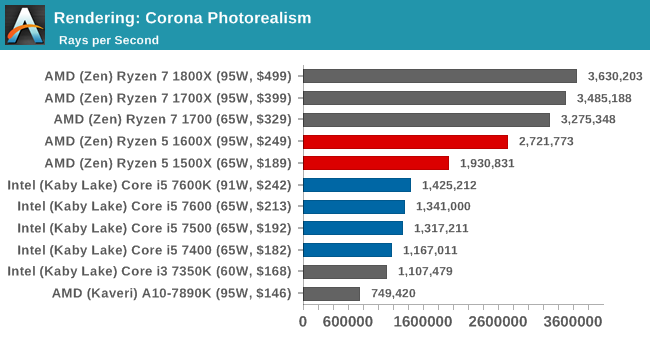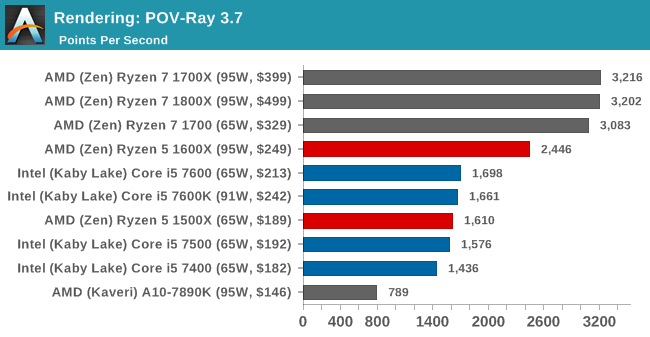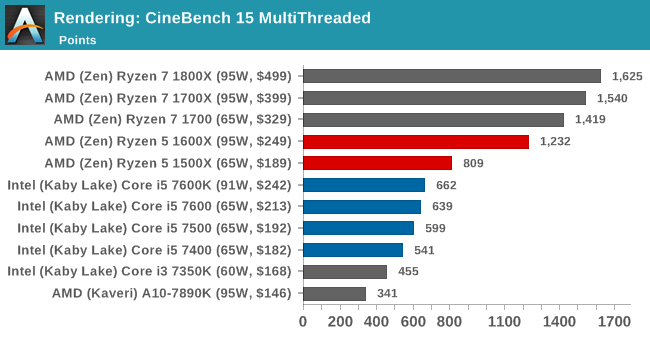The AMD Ryzen 5 1600X vs Core i5 Review: Twelve Threads vs Four at $250
by Ian Cutress on April 11, 2017 9:00 AM ESTBenchmarking Performance: CPU Rendering Tests
Rendering tests are a long-time favorite of reviewers and benchmarkers, as the code used by rendering packages is usually highly optimized to squeeze every little bit of performance out. Sometimes rendering programs end up being heavily memory dependent as well - when you have that many threads flying about with a ton of data, having low latency memory can be key to everything. Here we take a few of the usual rendering packages under Windows 10, as well as a few new interesting benchmarks.
Corona 1.3
Corona is a standalone package designed to assist software like 3ds Max and Maya with photorealism via ray tracing. It's simple - shoot rays, get pixels. OK, it's more complicated than that, but the benchmark renders a fixed scene six times and offers results in terms of time and rays per second. The official benchmark tables list user submitted results in terms of time, however I feel rays per second is a better metric (in general, scores where higher is better seem to be easier to explain anyway). Corona likes to pile on the threads, so the results end up being very staggered based on thread count.
Blender 2.78
For a render that has been around for what seems like ages, Blender is still a highly popular tool. We managed to wrap up a standard workload into the February 5 nightly build of Blender and measure the time it takes to render the first frame of the scene. Being one of the bigger open source tools out there, it means both AMD and Intel work actively to help improve the codebase, for better or for worse on their own/each other's microarchitecture.
POV-Ray 3.7.1
Another regular benchmark in most suites, POV-Ray is another ray-tracer but has been around for many years. It just so happens that during the run up to AMD's Ryzen launch, the code base started to get active again with developers making changes to the code and pushing out updates. Our version and benchmarking started just before that was happening, but given time we will see where the POV-Ray code ends up and adjust in due course.
Cinebench R15
The latest version of CineBench has also become one of those 'used everywhere' benchmarks, particularly as an indicator of single thread performance. High IPC and high frequency gives performance in ST, whereas having good scaling and many cores is where the MT test wins out.















254 Comments
View All Comments
msroadkill612 - Thursday, April 13, 2017 - link
Its worth noting that amd moboS historically tend to endure many revised cpuS. whereas an intel cpu upgrade for a user is bound to require a new mobo."ryzen 2" will probably simply drop into an am4 mobo.
Its also interesting that many or all the mobos i have seen are ready to go for an apu - video connects onboard e.g.
this indicates that raven ridge exists now, for pre-production mobo testing.
msroadkill612 - Thursday, April 13, 2017 - link
I dont believe amd would go to all the trouble of doing zen and vega, and then merge zen with prev gen polaris for the APU.it doesnt make sense from several perspectives. amd philosophy, the architecture seen in ryzen - 2 zen core blocks on a ccx simply becomes one core block and one vega gpu on a single ccx.
it will be a hell of a piece of silicon.
Johan Steyn - Friday, April 14, 2017 - link
Ryzen 9 is not that far fetched. Looking at the server part coming soon, an Ryzen extreme could be happening, especially for workstations. Maybe it might even fit AM4, although unlikely with quad channels. I do not think the current SOC has enough pins. So maybe we might get a Ryzen 9 with plenty of cores and quad channel memory.drajitshnew - Friday, April 14, 2017 - link
Dear Ian,Please clarify a point. You have mentioned that both AMD & Intel have 16 CPU PCIe lanes, but AMD offers 4 pcie lanes for storage from the CPU. If the chipset is loaded this could have an impact on the following 3 situations,
1. If the motherboard manufacturer routes those lanes from m2 to PCIe. Then those could be used, as storage, adding a GPU for GPGPU or a 10GbE NIC for use for a UHD media server, or AIC format storage.
2. With a heavily loaded chipset, a NVMe drive like a 1 TB samsung 960 pro or comparable, may show improved performance, specially in sequential transfers.
3. For a long lived system a large X-point or Z-nand or 3d SLC may show significant latency advantages.
cvearl - Sunday, April 16, 2017 - link
You have odd 480 results on GTA V. Are you using the final run (with the jet) from the built in test? My 480 scores in the mid 70's using your settings on that run with an i7 2600k.cvearl - Sunday, April 16, 2017 - link
Looking back at my GTX 1060 SC results (before I replaced with my 480) It had similar results to what you show here (Assuming the final run of the built in test). Am I to understand that the 480 gets a better result on i7 than Ryzen?Polacott - Monday, April 17, 2017 - link
my experience with AMD processors is that they have aged perfectly. I mean the AMD processors got more support and performance as apps and SO has been prepared to take advantage of more threads as years passed. I would get the Ryzen 1600X without any doubts over the i5.rmlarsen - Monday, April 17, 2017 - link
Unfortunate typo: In the conclusion it says "Looking at the results, it’s hard to notice the effect that 12 threads has on multithreaded CPU tests. " I believe the author meant to write "it's hard NOT to notice".Kamgusta - Tuesday, April 18, 2017 - link
Why in the Earth nobody ever considers the i7-7700?!?! And keep on putting the Ryzen CPUs only against the i5-7600K and/or the i7-7700K?i7-7700 has the same clocks as the i5-7600K, but double the threads and 2MB more L3. It consumes a lot less power than the i7-7700K and no more power than the i5-7600K. You can picture it as a more powerful i5-7600K or as a slight less powerful i7-7700K (but far more efficient).
If anyone is torn between R6-1600 and i5-7600K then the i7-7700 is, quite ironically, the best choice.
Ratman6161 - Tuesday, April 18, 2017 - link
So over the weekend I upgraded my system from an i72600K to a Ryzen 5 1600. First off, I could care less about gaming so I'll put that out there up front. I can buy (in order of real world price)i7 7700K for $300
ryzen 1600x would have been $249
Ryzen 5 1600 was $219
i5 7600K for $210.
I went with the R5 1600. For highly multi threaded tasks (remembering I don't care anything about games about games) the six core R5's compare very favorably with the i7 7700K even though most of the comparisons you see match them up against the i5. And the big difference between the 1600 and the 1600X is clock speed...and they are unlocked. So for me the 1600 ended up being a no-brainer.
So for us non-gamers anyway, i'd disagree with the i7 7700K being the best choice.
Also, when comparing prices, look at the platform price including motherboards. I got an Asrock AB350 Pro 4 for $39 bundled with the CPU so total price $258. Cheapest 7600K bundle at the same place: $315, cheapest 7700K bundle $465.